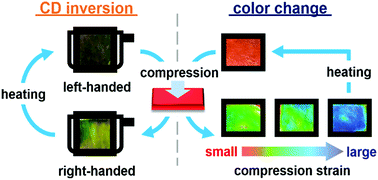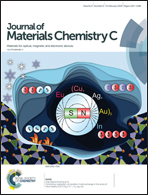Dual mechanochromism of cellulosic cholesteric liquid-crystalline films: wide-ranging colour control and circular dichroism inversion by mechanical stimulus†
Abstract
We prepared structurally coloured films composed of a cellulosic cholesteric liquid crystal (ChLC) and investigated their mechanochromic properties. The obtained ethylcellulose/poly(acrylic acid) (EC/PAA) films exhibited wide-ranging mechanochromism over the wavelength range of visible light upon compression at 130 °C, which was higher than the glass transition temperature (∼120 °C) of the composites. The compressed films displayed the ability to recover their shape and colour to a significant extent after thermal treatment at 130 °C for 10 s. Interestingly, we found that compressive stress inverted the cholesteric helix in the EC/PAA films, and their original helical handedness could be restored by thermal treatment at 130 °C. Compressive stress can thus alter not only the wavelength but also the handedness of circularly polarized light reflected from the EC/PAA films. This concept of dual mechanochromism, i.e., the mechanical control of these two optical properties, can be applied for displays, sensing, and so on.



 Please wait while we load your content...
Please wait while we load your content...